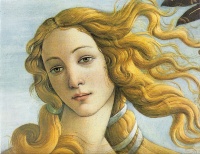The Birth of Venus
From The Art and Popular Culture Encyclopedia

Illustration: The Birth of Venus (detail), a 1486 painting by Sandro Botticelli
|
Related e |
|
Featured: |
The Birth of Venus (c. 1482–1486) is a painting by Sandro Botticelli. It depicts the goddess Venus, having emerged from the sea as a full grown woman, arriving at the sea-shore, representative for the Venus Anadyomene motif. The painting is housed at the Uffizi Gallery in Florence. Although her pose clearly has the modest of a Venus Pudica kind, her gaze is no doubt inviting.
Contents |
Origins
This large picture may have been, like the Primavera, painted for Lorenzo di Pierfrancesco de' Medici's Villa di Castello, around 1482, or even before. Some scholars suggest that the Venus painted for Lorenzo and mentioned by Giorgio Vasari may have been a different work, now lost. Some art historians believe it to be a celebration of the love of Giuliano di Piero de' Medici (who died in the Pazzi conspiracy in 1478) for Simonetta Cattaneo Vespucci, who lived in Portovenere, a town by the sea with a local tradition of being the birthplace of Venus. This claim, however, is dismissed as "romantic nonsense" by noted historian Felipe Fernández-Armesto:
The vulgar assumption, for instance, that she was Botticelli's model for all his famous beauties seems to be based on no better grounds than the feeling that the most beautiful woman of the day ought to have modeled for the most sensitive painter.
Whatever inspired the artist, there are clear similarities to Ovid's Metamorphoses and Fasti, as well as to Poliziano's Verses.
The classical goddess Venus emerges from the water on a shell, blown towards shore by the Zephyrs, symbols of spiritual passions. She is joined by one of the Horae, goddesses of the seasons, who hands her a flowered cloak.
The effect is distinctly pagan, considering it was made at a time and place when most artworks depicted Roman Catholic themes. It is somewhat surprising that this canvas escaped the flames of Savonarola's bonfires, where a number of Botticelli's other alleged pagan influenced works perished. Botticelli was very close to Lorenzo de' Medici. Because of their friendship and Lorenzo's power, this work was spared from Savonarola's fires and the disapproval of the church.
The anatomy of Venus and various subsidiary details do not display the strict classical realism of Leonardo da Vinci or Raphael. Most obviously, Venus has an improbably long neck, and her left shoulder slopes at an anatomically unlikely angle. Some have suggested it prefigures mannerism.
Classical inspiration
The painting was one of a series which Botticelli produced, taking as inspiration written descriptions by Pliny the Elder, Leonidas of Tarentum, Antipater of Sidon, Archias and the 2nd century historian Lucian of masterpieces of Ancient Greece which had long since disappeared. The ancient painting by Apelles was called Venus Anadyomene, "Anadyomene" meaning "rising from the sea"; this title was also used for Botticelli's painting, The Birth of Venus only becoming its better-known title in the 19th century.
The central figure of Venus in the painting is very similar to Praxiteles' sculpture of Aphrodite.
In classical antiquity, the sea shell was a metaphor for a woman's vulva.
The pose of Botticelli's Venus is reminiscent of the Venus de' Medici, a marble sculpture from classical antiquity in the Medici collection which Botticelli had opportunity to study.
Interpretation
The iconography of Birth of Venus is very similar to a description of the event (or rather, a description of a sculpture of the event) in a poem by Angelo Poliziano, the Stanze per la giostra. No single text provides the precise content of the painting, however, which has led scholars to propose many sources and interpretations. Art historians who specialize in the Italian Renaissance have found a Neoplatonic interpretation, which was most clearly articulated by Ernst Gombrich, to be the most enduring way to understand the painting.
For Plato – and so for the members of the Florentine Platonic Academy – Venus had two aspects: she was an earthly goddess who aroused humans to physical love or she was a heavenly goddess who inspired intellectual love in them. Plato further argued that contemplation of physical beauty allowed the mind to better understand spiritual beauty. So, looking at Venus, the most beautiful of goddesses, might at first raise a physical response in viewers which then lifted their minds towards the Creator. A Neoplatonic reading of Botticelli's Birth of Venus suggests that 15th-century viewers would have looked at the painting and felt their minds lifted to the realm of divine love.
More recently, questions have arisen about Neoplatonism as the dominant intellectual system of late 15th-century Florence, and scholars have indicated that there might be other ways to interpret Botticelli's mythological paintings. In particular, both Primavera and Birth of Venus have been seen as wedding paintings that suggest appropriate behaviors for brides and grooms.
See also

